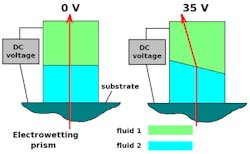Electrowetting variable-focus optics span visible to mid-IR
A type of electrically focusable, no-moving-parts type of lens (and a steering prism as well) developed by researchers at the University of Colorado (Boulder, CO) has a spectral band of 400 to 5000 nm and has been experimentally demonstrated at wavelengths of 588, 1550, and 3000 nm. The lenses are based on electrowetting, where varying a voltage changes the wettability and thus the contact angle of a fluid lens, also changing its shape. While the electrowetting concept itself isn’t new, the wide spectral range is. Uses include adaptive optics for imaging, spectroscopy, microscopy, lidar, and persistent surveillance.
The lens contains two fluids with differing refractive indices. The fluids are a room-temperature ionic liquid (RTIL) called N-Propyl-N- methylpyrrolidinium Bis(fluorosulfonyl)imide (Pyr133a) and dodecane.
An electrowetting lens with an indium tin oxide (ITO) substrate was made for visible-to-2000-nm applications, while a lens on a silicon substrate was fabricated for midwave-IR (MWIR) applications. The lenses had a focal range of about 7, 19, and 23 diopters at 588, 1550, and 3000 nm, respectively.
An electrowetting steering prism operating at 1550 nm was also fabricated that steered a beam over a 1.12° angle (which can easily be amplified with additional conventional optics, or by using a different nonpolar liquid in place of dodecane).
REFERENCE:
1. Alexander M. Watson et al., arXiv:1603.00421v1 (1 March 2016)
About the Author
John Wallace
Senior Technical Editor (1998-2022)
John Wallace was with Laser Focus World for nearly 25 years, retiring in late June 2022. He obtained a bachelor's degree in mechanical engineering and physics at Rutgers University and a master's in optical engineering at the University of Rochester. Before becoming an editor, John worked as an engineer at RCA, Exxon, Eastman Kodak, and GCA Corporation.

